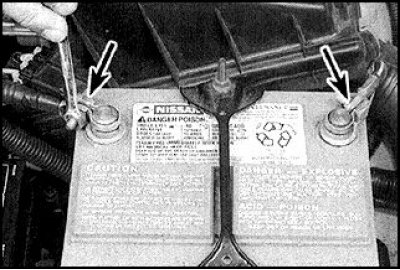Examination
Standard Batteries
1. With a low mileage of the car, it is recommended to check the density of the electrolyte every 3 months.
2. If you suspect a battery failure, compare the density of the electrolyte in the cells, which should differ by no more than 0.04. Otherwise, the plates are damaged or there is an electrolyte leak.
3. If the density differs within the specified limits, and the battery is discharged, then it must be charged.
Maintenance Free Batteries
4. The condition of the battery is determined by a voltmeter or by an indicator.
5. Battery status is determined by the color of the indicator, which depends on the type of battery (consult when buying).
6. When checking the voltage with a voltmeter, at least 6 hours must elapse after the last trip. Otherwise, turn on the high beam headlights for 30 seconds before checking.
7. The battery is completely discharged if the voltage is below 12.2V.
8. Discharged battery remove and charge.
Charger
Standard Batteries
1. The battery is charged with a current equal to 0.1 of the capacity until the density of the electrolyte stops changing for at least 4 hours.
2. The battery can also be charged with a small current of 1.5 A, leaving it overnight.
3. Boost charging is not recommended.
4. The temperature of the electrolyte during charging should not exceed 38°C.
Maintenance Free Batteries
5. Batteries of this type take a long time to charge (up to three days depending on the degree of discharge).
6. A partially discharged battery can be charged with a stabilized source of 13.9-14.9 V, typically 3 hours to a voltage of 12.5 V.
7. A completely discharged battery (with voltage below 12.2 V) it is recommended to charge in a specialized workshop, as constant monitoring is necessary during a long charge.
Removing

1. Loosen the nuts and disconnect the terminals (arrows) from the poles (the negative terminal is disconnected first).
2. Unscrew the nuts and remove the clamp, unhook the mounting studs.
3. Remove the battery and plastic tray.
Installation
1. Installation is carried out in the reverse order.
2. Connect the positive terminal first, then the negative terminal.
3. Lubricate the battery terminals with petroleum jelly.
Electrolyte density
| Above 25°C | Below 25°C | |
| Fully charged battery | 1,21 – 1,23 | 1,27 – 1,29 |
| 70% charged | 1,17 – 1,19 | 1,23 – 1,25 |
| Discharged | 1,05 – 1,07 | 1,11 – 1,13 |